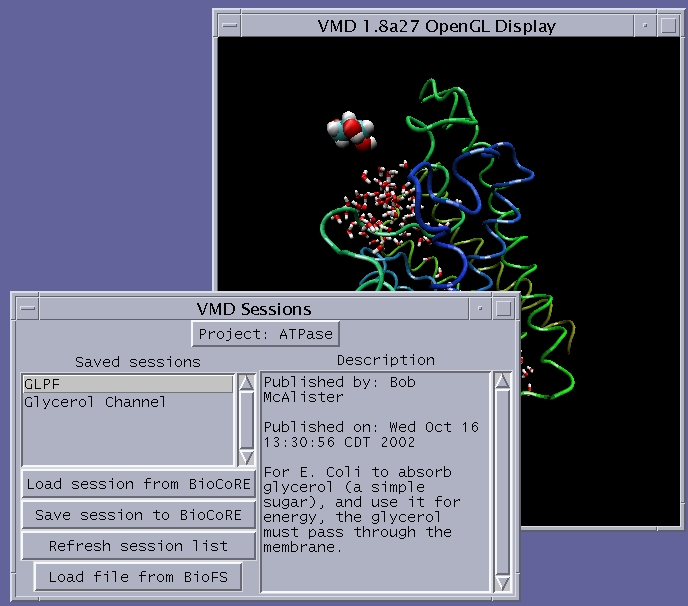BioCoRE For Training
BioCoRE provides useful tools for assisting with training, whether it be standard semester-long college or high school classes, or shorter workshops where students come to a lab for a brief period of time.
 BioCoRE has a number of features that will be described in the following
sections. As an instructor you can choose which BioCoRE modules
you want to utilize. Perhaps you only want start out by using the
BioFS for easy file transfer among you and your students. Perhaps
you only want to use BioCoRE's Control Panel for secure chatting
and office hours. Or, you might want to use a combination of
the various features that BioCoRE offers. If the class you are
instructing is doing Molecular Modeling, there are a number
of modules that will be particularly relevant for you.
BioCoRE has a number of features that will be described in the following
sections. As an instructor you can choose which BioCoRE modules
you want to utilize. Perhaps you only want start out by using the
BioFS for easy file transfer among you and your students. Perhaps
you only want to use BioCoRE's Control Panel for secure chatting
and office hours. Or, you might want to use a combination of
the various features that BioCoRE offers. If the class you are
instructing is doing Molecular Modeling, there are a number
of modules that will be particularly relevant for you.
We suggest that you create a BioCoRE project for the class. This can be done from any BioCoRE page once you've logged into BioCoRE. On the left column of the webpage near the bottom there is an option to 'Create Project'. We suggest naming the BioCoRE project something like "BioPhys 401 Fall 2005". This will give it a descriptive name that will be relevant over time. You are, however, free to name the project as you desire, as long as it doesn't conflict with an existing project name on the server.
Many features of BioCoRE can be used both before the class starts as well as once it is actually in progress. In a workshop environment you will probably know the membership before the workshop actually starts. Once initial class material has been added the class project (to give the students something to look at), we suggest that you contact the students and encourage them to create BioCoRE accounts if they don't already have one. Once they respond with their BioCoRE login names, you can can add them to the class project.
Sample Information that you can give to the students to acquaint them with BioCoRE
Sample Email you might send to your students inviting them to BioCoRE
For standard semester classes, information can be given out early in the term that describes the login process (see the above link), after which you can add the students to a class project.
Once the students are in the class BioCoRE project there are a number of things that they can do:
- The BioFS shared filesystem can be used as a repository of PDF, PPT, and other files. You can place your teaching files there and update them as needed. Students on Windows and Macintosh can use WebDAV to "mount" the BioFS and have it appear as a normal folder on their computer. Standard Unix filesystem permissions exist, so you can set your files to read-only and students can study the material before the class actually begins if they wish to do so. (more information)
- The Message Board and Control Panel can be used for communication among students and instructors before the class begins as well as during the class itself. One particular feature of the Message Board that you may find useful is the ability to notify other project members via email when a message is added to the Message Board. You can use this to keep students informed of new information about the upcoming class. Students will get an email telling them that a new message has been added to BioCoRE and provide them with a link that they can follow to view the message. (more information: Control Panel, Message Board, Lab Book)
-
 If you have VMD views that you want
to share with students, the
VMD Load/Save state feature can be used for this. You
can prepare your VMD states and save them to BioCoRE and this makes it
very easy for students to load up the state and "play" with it
(assuming they have VMD installed on their local machine. If they
don't, BioCoRE provides a static JPG image, viewable in the browser, of
the state as it was saved).
(more information)
If you have VMD views that you want
to share with students, the
VMD Load/Save state feature can be used for this. You
can prepare your VMD states and save them to BioCoRE and this makes it
very easy for students to load up the state and "play" with it
(assuming they have VMD installed on their local machine. If they
don't, BioCoRE provides a static JPG image, viewable in the browser, of
the state as it was saved).
(more information)
- The Link Library within BioCoRE can be used to store links to websites of interest to the students. If students find useful websites they can share the links with each other as well. (more information)
- Polls and Quizzes. As the adminstrator of the class project, you can create polls and quizzes for the students. You can create a poll (which doesn't have a correct answer) or a quiz (which you supply a correct answer for) and the students will then get a box on their BioCoRE Control Panel where they can choose an answer. The answer is then recorded and you can view the results on the web pages. (more information)
- Students can self-report their background biographical information and this will be shared among group members. Since it is self-reported they can choose whether or not they wish to provide any information but if everyone does, this gives a good way for everyone to learn more about their classmates. (more information)
Once the class has actually started, BioCoRE remains a useful tool for hands-on sections of the class where students have access to a computer. The features listed above continue to be relevant but there are also new features who's usefulness becomes apparent. In particular, students might not be experts in molecular modeling before the class begins.
- For MD beginners in particular, the NAMD Configuration File
Generator can be a big help. Students can fill in the boxes and end up
with a NAMD configuration file. Online help is available and the
configuration file can be saved to the BioFS or to their local
machine.
(more information)
As an instructor in the computer lab, it would make good sense to have a view of your own BioCoRE session transmitted via a LCD projector so that students can "follow along" as you use the NAMD Configuration File Generator to create an input file. You can explain relevant values to students and they can be "testing" the File Generator to see the results in the text file as you do this.
- Once students have their NAMD config file in the BioFS (along with other files required for the simulation that you have already put in the BioFS, you can show them how to submit a job to the supercomputer which they can then do using the Job Management feature of BioCoRE. They tell what files they need to have uploaded, and what files they expect back and BioCoRE will perform the operation.
Other useful pieces of information:
- The class project can have a public area where materials may be posted for the use of all BioCoRE members, not just students in the class. However, not all BioCoRE modules are available to public members, and information posted to the normal areas of a project is only accessible to project members, so actual students of the class would want to become members of the private class project.
Feedback
The BioCoRE team welcomes any comments, questions, or suggestions that you might have concerning our software! Please email us or fill out our feedback form.




